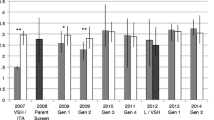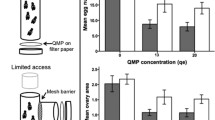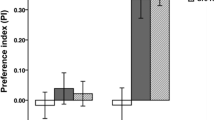Abstract
Disruptive selection for responsiveness to queen mandibular gland pheromone (QMP) in the retinue bioassay resulted in the production of high and low QMP responding strains of honeybees (Apis mellifera L.). Strains differed significantly in their retinue response to QMP after one generation of selection. By the third generation the high strain was on average at least nine times more responsive than the low strain. The strains showed seasonal phenotypic plasticity such that both strains were more responsive to the pheromone in the spring than in the fall. Directional selection for low seasonal variation indicated that phenotypic plasticity was an additional genetic component to retinue response to QMP. Selection for high and low retinue responsiveness to QMP was not an artifact of the synthetic blend because both strains were equally responsive or non-responsive to whole mandibular gland extracts compared with QMP. The use of these strains clearly pointed to an extra-mandibular source of retinue pheromones (Pankiw et al. 1995; Slessor et al. 1998; Keeling et al. 1999).
Similar content being viewed by others
Author information
Authors and Affiliations
Additional information
Received: 2 March 2000 / Accepted in revised form: 4 September 2000
Rights and permissions
About this article
Cite this article
Pankiw, T., Winston, M., Fondrk, M. et al. Selection on worker honeybee responses to queen pheromone (Apis mellifera L.). Naturwissenschaften 87, 487–490 (2000). https://doi.org/10.1007/s001140050764
Issue Date:
DOI: https://doi.org/10.1007/s001140050764




